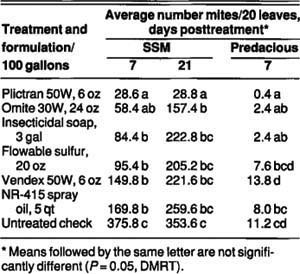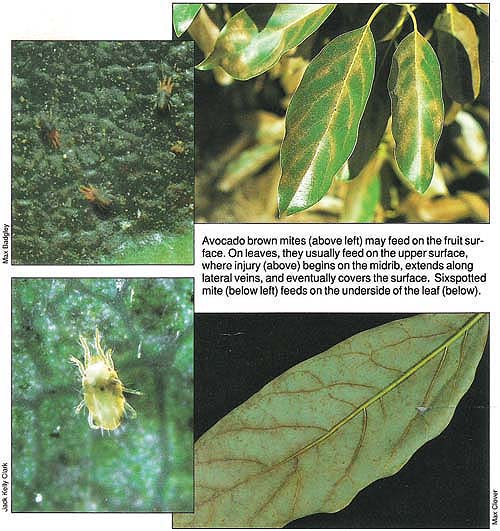All Issues
Control of two avocado mite pests
Publication Information
California Agriculture 44(2):31-32.
Published March 01, 1990
PDF | Citation | Permissions
Abstract
Several materials were tested for possible use when avocado brown mite and sixspotted mite populations build up, threatening to cause extensive leaf drop. Sulfur was effective against avocado brown mite. Others, at present unregistered for this use, were effective against both mites.
Full text
Avocado brown mite and the sixspotted mite are the two most common mite pests of California's 75,000 acres of commercial avocados. Generally, outbreaks of avocado brown mite occur in areas with a coastal or intermediate climate in southern California. Sixspotted mite infestations have been largely confined to lemons and avocados growing in the coastal areas of Santa Barbara and San Luis Obispo counties. In most instances of sixspotted mite infestations on avocados, the grove has been near an infested lemon grove. Highest populations of both mite species are usually seen during late summer and early autumn. Both mites produce webbing on leaf surfaces.
Avocado brown mite, Oligonychus punicae (Hirst), is found on the upper sides of avocado leaves. Feeding injury begins on the midrib and extends out along the lateral veins, eventually covering the entire upper surface. When populations are very high, this mite will move onto lower leaf surfaces. Feeding removes chlorophyll, causing leaves to turn a brownish color, commonly referred to as bronzing. The avocado brown mite also removes chlorophyll from the surface of avocado fruit, which sometimes results in downgrading by packinghouses.
Studies have shown that bronzing reduces transpiration and photosynthesis rates (California Agriculture, May-June 1982). Leaves can recover from this injury, but may not if the infestation persists. Extensive leaf drop is likely to occur if avocado brown mite population densities reach an average of 75 to 100 adult females per leaf for short periods, or when densities remain at 50 females per leaf for several weeks.
The sixspotted mite, Eotetranychus sexmaculatus (Riley), is found on the undersides of leaves and is not confined to any particular area. In high populations, however, they seem to prefer areas immediately adjacent to the midrib and larger lateral veins. Feeding causes removal of chlorophyll and development of grayish spots or blisters. Leaf drop occurs when population densities reach an average of 5 to 10 adult male and female mites per leaf.
Only sulfur or narrow range 415 (NR-415) spray oil are currently registered for use to control mites on bearing avocados in California. The use of NR-415 spray oil is restricted to the Hass variety of avocado. However, neither material has been considered entirely effective for controlling either pest.
In search of more reliable materials, we tested six products in two field trials. Products tested were Plictran (cyhexatin), Omite (propargite), Vendex (fenbutatin oxide), flowable sulfur, insecticidal soap, and NR-415 spray oil. The first three materials are well-known acaricides used on many food and ornamental crops. Insecticidal soap is safe to use around human habitation, and other researchers have reported that it gives fair to good control of other mite species. Sulfur and NR-415 spray oil were included for comparison.
TABLE 1. Control of avocado brown mite (ABM) with acaricides, Santa Barbara County, September-October 1982
TABLE 2. Control of sixpotted mite (SSM) with acaricides, Santa Barbara County, September-October 1982
Methods
In both trials, materials were applied by handgun from an orchard hydraulic spray rig at 400 pounds per square inch. The dilution factor for all materials was based on 1,000 gallons per acre, that is, 10 gallons spray per tree times 100 trees per acre. All trees were sprayed to the point of runoff. Rates of chemicals applied in both studies are presented in tables 1 and 2.
A randomized block experimental design was used with five single tree replicates of each treatment and a single tree buffer separating each test tree. Treatments were evaluated by taking random samples of 20 leaves, at a height of 2 to 8 feet above the ground from each of the treated and untreated trees. Samples were taken to the UC South Coast Field Station, where they were kept at 40°F until examined.
All samples were examined with a dissecting microscope within 3 days of collection. Only motile stages of the mites, on both sides of one-half of each leaf, were counted. Leaves were examined for both pest mites and predacious mites, in particular Euseius hibisci (Chant).
Avocado brown mite trial
The avocado brown mite trial was conducted in a 9-year-old Hass avocado grove in Santa Barbara County. The population before treatment was high, providing useful conditions in which to evaluate acaricide efficacy.
A count taken 7 days after treatment showed Omite, Plictran, Vendex, and sulfur to be significantly superior in mite control to insecticidal soap or oil. However, the latter two provided considerable suppression (table 1).
All treatments substantially reduced predacious mite populations. Omite and Plictran treatments resulted in the greatest reduction of beneficial mites, whereas Vendex, sulfur, and oil were the least damaging. Declining avocado brown mite and predacious mite populations precluded any further sampling.
Sixspotted mite trial
The other trial was conducted in a 20-year-old Hass avocado grove on a 20-by 40-foot spacing, also in Santa Barbara County. A pretreatment leaf sample taken on the day of treatment showed an average of 28 sixspotted mites per leaf. This is four to five times the number generally observed to cause leaf drop; leaf drop was extensive.
Plictran out-performed all other materials tested for control of sixspotted mite at both the 7- and 21-day intervals after treatment. Omite provided adequate control at the 7-day count (table 2). At that count, Omite, Plictran, and insecticidal soap also significantly reduced predacious mite populations. Vendex and sulfur had the least effect. Beneficial mites were not counted 21 days after treatment.
Avocado brown mites (above left) may feed on the fruit surface. On leaves, they usually feed on the upper surface, where injury (above) begins on the midrib, extends along lateral veins, and eventually covers the surface. Sixspotted mite (below left) feeds on the underside of the leaf (below).
Omite 30 W caused some spotting on the undersides of leaves in both trials. However, Omite CR has produced fewer phytotoxic effects in other tests. No phytotoxicity was noticed on the leaves or fruit of any of the other treatments.
Conclusions
Omite, Plictran, Vendex, and sulfur were equally effective in controlling avocado brown mite. Of the materials tested in our study, both Vendex and sulfur were effective and caused the least reduction of predacious mites. Vendex, as well as Omite and Plictran, however, are not registered at present for this use on bearing avocados in California.
Even though less common than avocado brown mite on avocados, sixspotted mite appears to be more damaging because low population densities can cause extensive leaf drop. Omite was the only effective material, other than Plictran, against sixspotted mite in our studies.
Generally, both avocado brown mite and sixspotted mite are kept under adequate control by the predacious mite Euseius hibisci as well as another fairly common predator, the Stethorus beetle, or even less common predators. The misuse of chemical treatments can significantly reduce populations of beneficial species and, in turn, can result in outbreaks of mite pests. Chemical treatments for mite control may be desirable to prevent extensive leaf drop, if mite populations threaten.







